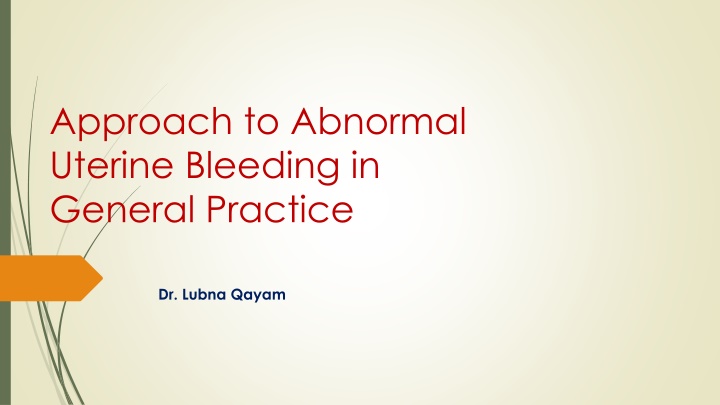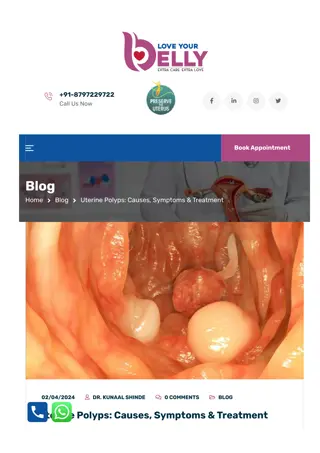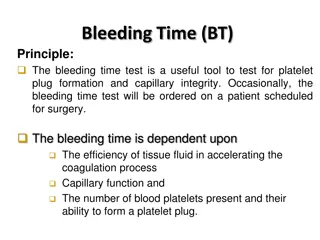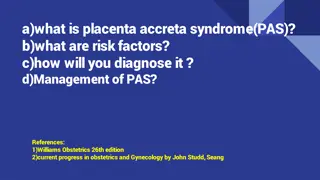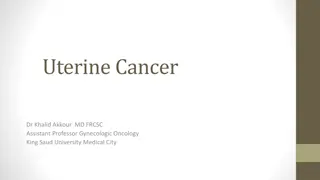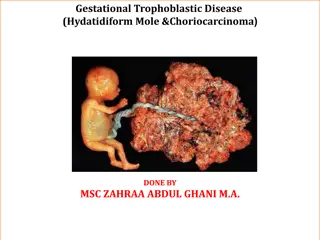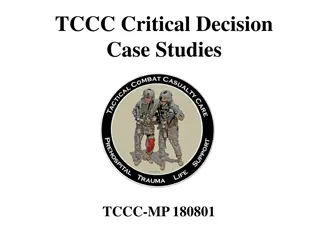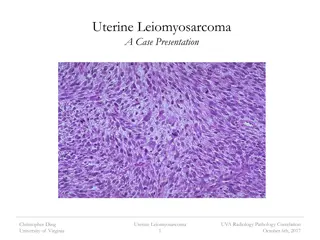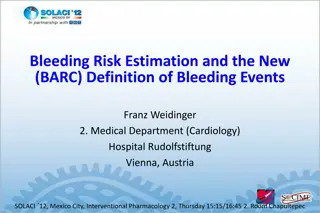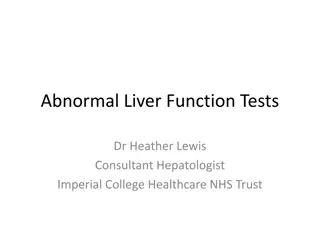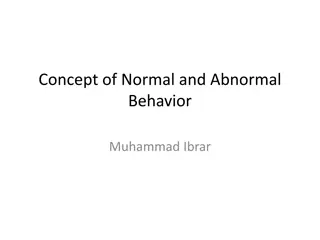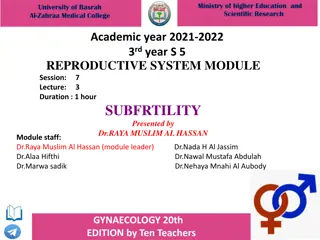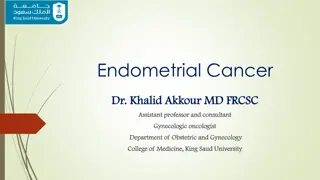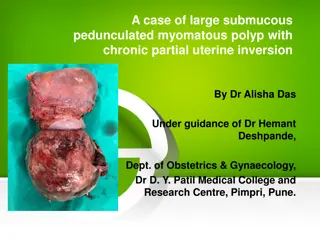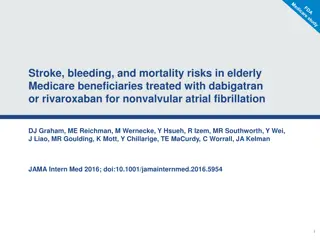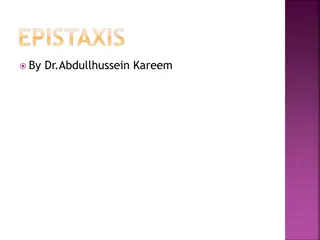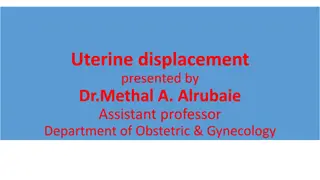Comprehensive Guide to Abnormal Uterine Bleeding: Causes, Approach, and Management
Explore the approach to abnormal uterine bleeding in general practice with Dr. Lubna Qayam. Dive into different scenarios of patients presenting with varied symptoms and histories. Learn about the causes of abnormal uterine bleeding in reproductive age and post-menopausal women, including anovulatory and ovulatory factors. Gain insights into the management and treatment options for patients experiencing irregular bleeding patterns.
Download Presentation

Please find below an Image/Link to download the presentation.
The content on the website is provided AS IS for your information and personal use only. It may not be sold, licensed, or shared on other websites without obtaining consent from the author.If you encounter any issues during the download, it is possible that the publisher has removed the file from their server.
You are allowed to download the files provided on this website for personal or commercial use, subject to the condition that they are used lawfully. All files are the property of their respective owners.
The content on the website is provided AS IS for your information and personal use only. It may not be sold, licensed, or shared on other websites without obtaining consent from the author.
E N D
Presentation Transcript
Approach to Abnormal Uterine Bleeding in General Practice Dr. Lubna Qayam
Outline Causes Approach Management
Scenario 1 A 32 year old lady P2 c/o spotting in between her periods, post coital bleeding with regular periods which lasts for 4-6 days, mild dysmenorrhoea, no dyspareunia. There is no significant medical history. There was a h/o STI in past which was treated successfully and she is in stable relationship for 5 years. She takes CHC.
Scenario 2 A 48 year old lady P2 with a h/o normal and regular periods in past. She is c/o irregular periods with prolonged bleeding pattern lasting for 5-9 days for 6-8 months . No post coital or intermenstrual bleeding. She had an USS done recently showing ET 2.5 mm with normal ovaries. Her recent blood tests are normal. She uses condoms as contraception.
Scenario 3 4. A 25-year-old woman who has been using the progestogen-only implant presents with irregular bleeding since starting 7 months ago and would like treatment or for it to be removed. She has no significant medical history. After consideration and exclusion of other factors, what is the appropriate treatment to offer her?
Scenario 4 3. A 37-year-old woman who has had the levonorgestrel-releasing intrauterine system (LNG-IUS) for 9 months complains about the irregular spotting she has always experienced with this method. She wishes to control the bleeding while on holiday. She has no contraindications to hormonal contraceptives.
Causes of AUB AUB Reproductive Age PALM-COIEN Post Menopausal COEIN: Non structural Coagulopathy Ovulatory dysfunction Endometrial Itrogenic( tamoxifen, HC, anticoagulants, herbel meds, steroids) Not yet classified PALM: structural causes Polyps,pregnancy Adenomyosis Leiomyoma Malignany and hyperplasia Hyperthyroid (21%) Hypothyroid (23%)
Causes of AUB AUB Anovulatory -Just after menarche -perimenopausal -Hypothalamo- pituitary axis disturbance -UnoppsedEstrogen absence of progesterone results in unpredictable, irregular and prolonged bleeding patterns e.g.PCOS, thyroid, ^prolactin Ovulatory - Menorrhagia with regular periods
How to approach History: age, Menstrual Hx, Sexual Hx, Obstetric/ Gynae Hx Past medical Hx Drug Hx Family Hx Examination: systemic illness, galactorrhoea, A Nigricans, hirsuitism, Acne, Abdo, PS, PV Investigations: Exclude pregnancy, Swabs for STI, Check recent Cx screening result, Blood test( FBC, Clotting, TFT, LFTs), USS pelvis Treatment: Treat the cause
Treatment of Anovulatory bleeding Progestogens like Nor-Ethisterone or medroxyprogesterone To arrest the heavy bleeding Then cyclically COC pills for 3-6 months
Treatment of heavy menstrual bleeding (Menorrhagia) If women is not wishing for contraception or while waiting for the Investigations/if fibroid is less than 3 cm Mefanemic acid with Tranexamic acid is the 1st choice If Long term contraception is acceptable then LNG-IUS is the 1st choice 2nd Choice COC that reduces dysmennorhoea and regulate cycles 3rd Choice Nor-ethisterone day 5-26 ( not effective contraception, but may inhibit ovulation)or Depo- provera 12 weekly GNRH analougues Not recommended in PC, but a good option in SC
Treatment of Menorrhagia If initial 1st line Rx fails then combine Tranexamic acid + Nsaids (dysmenorrhoea) Nsaids + COCpills To arrest heavy bleeding NEST 5mg- 10mg tds for 10 days ( stops bleeding with in 1-3 days, with drawl bleed occurs 2-4 d after stopping Rx) REFERRALS: Alarm symptoms QOL is negatively affected by menorrhagia Women wishes to have surgery Fe deficiency anaemia that fails to respond to pharmaceutical treatment
Problematic bleeding with hormonal contraception It is challenging. For many women it is due to the contraceptive method itself Women may consider that the contraceptive and non-contraceptive benefits of a method outweigh the inconvenience of unpredictable bleeding. Assessment should be by Clinical history Exclude STI - perform speculum exam and take swabs at least for chlamydia Check cervical screening history Consider the need for a pregnancy test Exclude underlying pathology
Medical Therapy options for women using hormonal contraception with problematic Bleeding CHC users Reassurance for 1st 3 M , increase EE up to max 35micrograms POP users may try a different POP, Estrogen supplementation or tranexamic acid PO implants, injectibles and IUS EE 30-35 micr with LNG/ norethisterone or mefanemic acid 500mg tds with tranexamic acid 1gm qds as s short term therapy.
Causes of Post Menopausal Bleeding Atrophic vaginitis 60-80 % HRT 15-25% Polyps- endometrial or cervical 2-12% Endometrial hyperplasis 5-10% Endometrial carconima 10% Estrogen secreting ovarian tumours( Granulosa, Theca cell) <1% Traumatic e.g ring pessary
Scenario 5 A 55 year old lady with an LMP 5 years ago presented with vaginal bleeding off and on. She is sexually active. She denies any medical history and does not take any OTC medications. O/E BP 142/88, BMI of 35, fresh bleeding in the vagina with a small blood clot on her right labia. Cervix looks healthy. Bimanual examination is satisfactory. How will you proceed?
History When? Nature, precipitating factors like SI, Trauma Discharge HRT, tamoxifen, Anticoagulants Any recent unintentional weight loss, fever, abdo pain, personal and family h/o endometrial, breast, ovarian / colon cancers, (LYNCH II) bladder bowel change Parity Age of menarche and menopause Smoking HTN, DM Last smear result
Examination Vital signs BMI Signs of anaemia Abdominal examination to assess the size, Contour, tenderness of uterus, visceromegaly, ascites. Speculum examination see vulva, vagina, signs of atrophy, bleeding, growths on vaginal wall/ cervix, abnormal discharge Bimanual exam to look for size of uterus, mobility, fullness of adnexa and tenderness. If suspected endometrial cause of bleeding, perform the pipelle biopsy and refer as 2WW ref to gynaecology.
Atrophic Vaginitis Presents with soreness and dryness of vagina, vaginal bleeding, supf dyspareunia, dysuria, recurrent UTI and vaginal discharge. Thinning of the vulval and vaginal epithelium Loss of glycogen Fall in acidity Absence of protective lactobacilli Estriol creams/ pessaries daily for 2 weeks then twice weekly for 3 months.(Ovestin, Vagifem, Orthogynest, Premique, Prempak) No evidence that topical Estrogens causes endometrial proliferation after 6-24 m of use therefore no need to prescribe systemic progestogens. Vaginal lubricants can be use with or with out local Estrogen treatment.
PMB with HRT Unscheduled Vaginal bleeding is a common adverse effect of HRT in first 3m of treatment. CCHRT- Commonly produces irregular breakthrough bleeding in first 4-6 m. Bleeding beyond 6m or after the spell of amenorrhoea requires further investigations. Once risk of malignancy is excluded then try low dose Estrogen or ^ progesterone regimen. Sequential HRT should produce regular predictable bleeding starting towards or soon after the end of progesterone phase. Increasing the duration, dose or type of progestogen is recommended.
References: 1. FSRH guidelines 2. Nice guidelines
